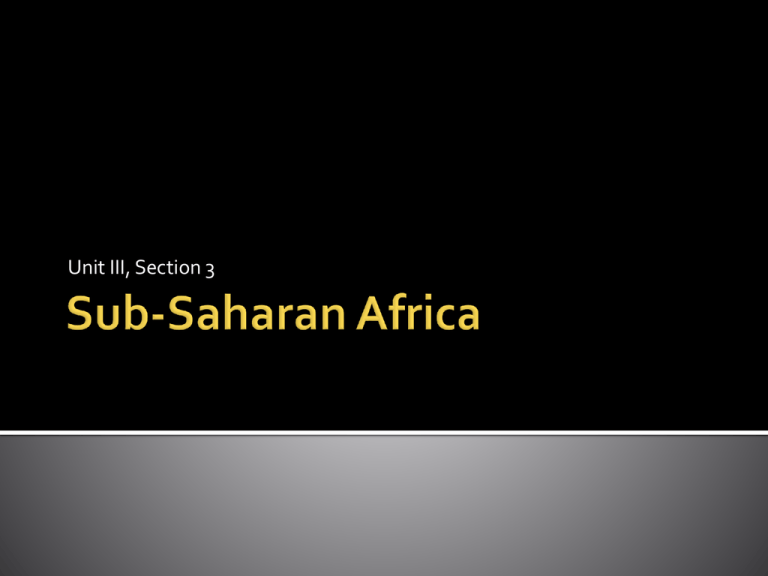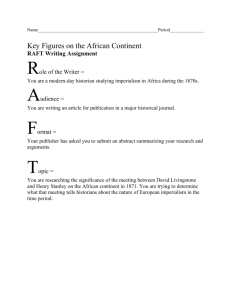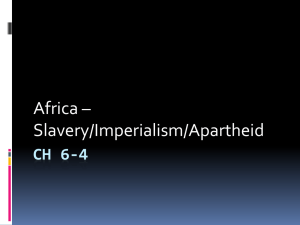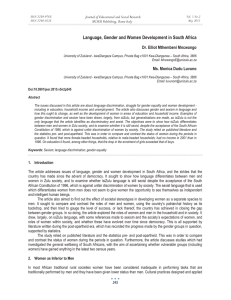Sub-Saharan Africa - mrjhallsclassroom
advertisement

Unit III, Section 3 Understand the complex and varying climate regions and resource deposits across the continent. Define the influence left by other cultures, i.e. Europeans & Muslims Analyze the challenges facing Sub-Saharan Africa. Describe Africa’s place in the World as an economic force and as a force of change and growth. Detail the events of conflict across Africa, such as the Rwandan genocide and Apartheid. Border between savanna grasslands & deserts Means “shore” in Arabic Extends from Senegal to Sudan Pasture land ▪ Herding groups ▪ Low growing grasses & shrubs ▪ Acacia trees 4 to 8 Inches of rain annually ▪ Rain Mostly falls in June, July, & August Gerenuk Cheetah African Wild Dog ScimitarHorned Oryx North central Tanzania 38,000 square miles 2 million herbivores, thousands of predators Variations in grasslands, scrub, and woodlands Rainy season- March thru May Kopjes- granite outcrops Ol Doinyo Lengai Active volcano Only carbonatite volcano on Earth ▪ Lava turns white when it contacts air Annual migration of nearly 1.5 million wildebeests & 300,000 zebra & other antelopes Stretches from Tanzania to Kenya 1,800 mile journey Search for viable grasslands Year long breeding cycle All wildebeest calves born within a three week period, February Crosses a series of rivers, plains, & salt flats Nearly ¼ of a million wildebeests do not complete the journey Only began in the 1960’s East African people group Kenya & Tanzania Semi-nomadic herders Kraal homesteads Traditional society Men- hunt, herd, and protect Women- build homes & care for the family Wealth based on livestock Tourist/western influences 60 to 110 inches of rain annually Ground level vegetation ▪ Shrubs, ferns, & mosses (rises 6 to 10 feet) Middle level vegetation ▪ Small trees & palms (Rises to 60 feet) Upper level vegetation ▪ Leafy trees (rises up to 150+ feet) ▪ Orchids, ferns, & mosses grow at this level Poor soil for commercial grain crops ▪ Bananas, pineapples, cocoa, tea, coffee, & cotton Deforestation Okapi Gorilla Bongo Green Mamba Mid-latitude Found in South Africa Known as a Mediterranean climate Snow can occur Lush vegetation Thick woodlands Excellent agricultural lands Kudu Hartebeest White Rhino Impala 3000 miles long Fault system, N. Syria to Central Mozambique 30 active or semi-active volcanoes Rich source of life Bio-diversity Hominid Fossils ▪ Richard & Mary Leakey ▪ Olduvai Gorge ▪ Perfect environment ▪ Prehistoric highway Okavango Delta Large in-land delta Water evaporates, never reaches the sea Threatened by hydroelectric construction Congo World’s deepest, 720 ft 2nd Largest River in the World 2,920 miles long Main water route for West-central Africa Discovered by John Speke in 1858 Named for Queen Victoria 26,600 square miles 2nd largest lake in the World Largest tropical lake Average depth of 130 ft Source of the White Nile Threatened by pollution Waste water/water hyacinth 19,341 feet high Highest peak in Africa Highest free standing mountain in the World Dormant volcano Three cones ▪ Kibo, Mawenzi, Shira Sky Island Endemic plant species only found on the mountain Southern African coastal desert 1,200 miles long Oldest desert on Earth Coast sand seas/inland gravel plains Watered by ocean fogs Ostrich Gemsbuck Meerkat Jackal Group Of The Most Dangerous & Largest Big Game Animals In Africa African Elephant ▪ Vulnerable Black Rhino ▪ Critically Endangered Cape Buffalo ▪ Least Concerned Leopard ▪ Near Threatened Lion ▪ Vulnerable Oil Largest industry in Nigeria ▪ Greatest percentage of the GDP ▪ Criticism for harming the countries economy ▪ Natural degradation Diamonds & Gold South Africa, Congo, & Botswana ▪ Large scale, deep earth mining ▪ Workers rights, poor conditions, etc. ▪ “Blood Diamond” controversy Early migrations out of Africa H. erectus 1.8 million years ago Great Rift Valley through the Levant All hominid species developed in Africa Minus Neanderthal H. sapiens Migrated around 125,000 years ago Neolithic Revolution Ethiopian Highlands, the Sahel, and W. Africa Rice, yams, oil palm, and coffee Manden Kurufaba 1230-1600 C.E. Mansa Musa 1280-1337 Devout Muslim, Hajj pilgrimage Furthered Timbuktu’s influence Driving force of West Africa Gold, salt, copper, and the slave trade 1st continent to be looked to Refuge for the persecuted Adapted to African culture Developed separately from Arabian or Asian Islam Social autonomy Spread by Conquest in the North Trade in the South Considerable force in today’s Africa Colonization First attempted by the Romans Greater push into the Continent during the 18th & 19th centuries ▪ Carving up the “Dark Continent” Early exploration restricted to the coast ▪ 1 to 2 year life span for white settlers The Slave Trade Viable economic source for West African kingdoms ▪ Islamic coastal kingdoms ▪ Exportation to the Islamic World, Europe, & the Americas Slave characteristics ▪ Young males ▪ Interior Africans ▪ Desirable skills (part. for the New World) ▪ Farming, skin color, metal working, etc. The Civilization Process “The White Man’s Burden” ▪ Bring society, civility, and Christ to the heathens ▪ By force or choice ▪ Part of the colonial expansion David Livingstone ▪ Protestant missionary ▪ Victorian hero ▪ Disappeared for 6 years ▪ Henry Morton Stanley sent to find him ▪ Died May of 1873 1879 British vs. the Zulu Kingdom British attempted to bring South African unity Boers & Zulu and obstacle Early Zulu victories at Isandlwana Boer ally, Paul Kruger Battle of Ulundi clinched Anglo victory Saw dissolution of Zulu dynasty Imprisonment of Chief Cetshwayo Conflicts between Cape British and Transvaal Boers Dutch/Afrikaans word for farmer Boers free states in Orange, South African & Transvaal Republic Persecution of Boer settlers Concentration camps 1st, Dec. 1880- March 1881 2nd, Oct. 1899-May 1902 Union of South Africa est. in 1910 Crops grown for sale at a profit Purchased by groups outside of agriculture 60% of Africans are employed in farming 3/5 of farmers subsistent farmers African cash crops Coffee, cotton, tea, & rubber Global markets undercut prices African producers unable to compete Began April 7, 1994 100 days of slaughter Up to a million Tutsi and moderate Hutu killed Prompted by years of ethnic tensions Final blow was the death of the Rwandan president Interhamwe, armed civilian groups World was aware of the violence Limited Western intervention “Apart-hood” Racial segregation of South Africa, 1948-1994 Suppressed movements of blacks Allowed Afrikaner minority to maintain power Separation of four racial groups Black, white, colored, & Indian Forced movements, educational separation, & removal of black citizenship (1970) Internal violence and protests Reforms began in the 1980’s 1990- Pres. Fredrick Willem de Klerk begins negotiations to end Apartheid 1994-Multi-racial elections held Nelson Mandela wins presidency Nelson Mandela, 1918-2013 Political Activist Spent 27 Years In Prison, Robben Island Freed After The End Of Apartheid First Democratically Elected President After Apartheid (1994-1999) Proponent of equality and peace Died of a respiratory infection Global mourning upon his death HIV/AIDS Origins in equatorial Africa, bush meat trade First epidemic in Kinshasa in the 1970’s Spread through unsafe practices Major economic/societal drag for Africa Ebola Carried naturally by fruit bats Spread through contact with infected bodily fluids High incidents of death Bleeding, fever, kidney failure, etc. Taking animals illegally Major source of income for poor Africans Used for Bush meat, illegal pet trade, traditional medicine, & tourist interests Species decline African elephant, black rhino 2011, 23 tons of illegal ivory seized (2,300 elephants) Countries stepping up with anti-poaching initiatives Provisions of resources Clean water, food, functioning space Equality of education Protection of human rights Protection of natural resources Advancements economically








